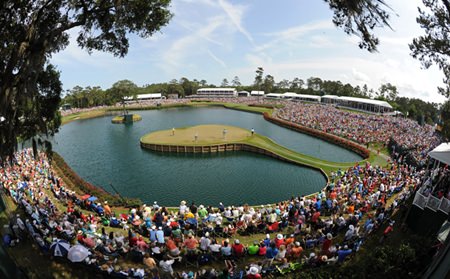This last week saw the staging of the Players Championship – the PGA Tour’s flagship event – held at their headquarters in Ponte Vedra Beach, Florida. Staged on the iconic TPC Sawgrass course, the event is talked up by many in US golf media as the world’s 5th major, and according to the PGA Tour it should be.
Really?
The PGA Tour, not to be confused with the PGA of America, is the organiser of the main professional golf tour played by men in North America. It also runs the Champions Tour (for golfers over 50), as well as the Web.com Tour, the PGA Tour Canada, PGA Tour Latin America and PGA Tour China.
 Golf’s most recognisable hole? – the TPC Sawgrass par-3 17th.
Golf’s most recognisable hole? – the TPC Sawgrass par-3 17th.
Originally established by the Professional Golfers’ Association of America (PGA of America), the PGA Tour was spun off in 1968 into a separate organisation for tour players. The split was such that relationships between the two organisations have ranged from strained to something less than cordial, to this day.
Whereas the PGA of America has some 27,000 members – mostly club pros – the PGA Tour caters to that small number of golfers who are good enough to earn their living playing golf – the elite.
In terms of size of organisation, the PGA Tour is small. In terms of the influence they have on the game, they are big, and want to get bigger. Establishing PGA Tour China is evidence of their ambition. Tour Commissioner Tim Finchem is arguably the most quoted administrator in golf. His anti USGA stance on the anchoring debate was typical of his promotion of the PGA Tour as the organisation that knows what is best for the game.
That Commissioner Finchem knows what is best for golf is doubtful. What is not is that few know more about getting dollars into the pockets of touring pros, and that is his primary focus.
In spite of their high profile, the PGA Tour lacks one important asset that others have, and they covet – a major!
The Masters is run by Augusta National, the US Open by the USGA, the Open Championship by the R&A, and the PGA Championship by the PGA of America.
The next biggest thing in golf is the Ryder Cup, which is jointly run by the PGA of America and the PGA European Tour. Yes, that is right – the PGA Tour has nothing to do with the Ryder Cup.
So what did they do about this?
In 1994 they set up the President’s Cup – a series of golf matches between a team representing the United States and the rest of the world minus Europe. It runs in alternate years to the Ryder Cup. It struggles for recognition, ratings and relevance.
Women’s golf is the province of the LPGA.
That leaves the remaining 40-plus events run week-to-week, including the FedEx Cup events, and of course this most important of events – the Players Championship.
In attempting to justify the label of “fifth major” the PGA Tour ensured that the prize fund was the highest in tournament golf. Other rewards associated with winning the Players Championship include: 80 world ranking points (10 more than normal), a five-year exemption on the PGA Tour (a normal win gives two-years), a three-year invitation to the Masters Tournament, same for the US Open and The Open Championship, and 600 FedEx Cup points (100 more than normal).
Notice what’s missing? The PGA Championship, the world’s fourth major and the one run by the PGA of America, allows the Players winner just the one exemption – for that year’s PGA Tournament run in August. So that may suggest how the PGA of America rates it (note; the winner of the PGA Tournament receives a five-year exemption to all other majors and the Players Championship).
Also, unlike the three major championships staged in the United States, the Players Championship is not considered an official event on the European Tour.
So, in summary, the Players Championship, according to its promoters, should be considered the fifth major due to its prestige, its considerably larger purse, and the “fact” that it is always “the best field in golf,” as was often mentioned by on-course broadcasters genuflecting to the PGA Tour.
Problems with this argument include the fact that the winner is not recognised as a major champion and never will be, and there is something presumptuous about such a claim, especially when the field does not include two golfers ranked in the top-ten, including the world’s number one!
Oh, and congratulations to this year’s winner, Martin Kaymer from Germany, whose winning score was 13-under par.
The fifth major? I don’t think so.
Golfnutter




